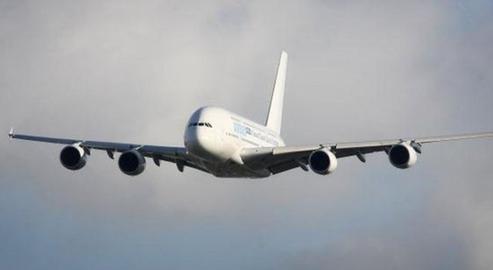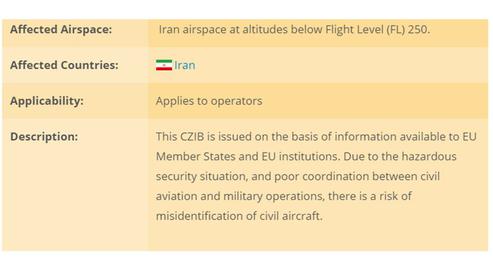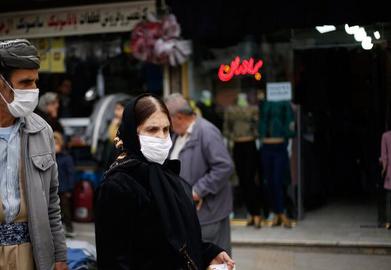The European Union Aviation Safety Agency (EASA) has issued a statement on the safety conditions of Iranian airspace to airline companies worldwide – warning that "military and passenger aircraft are under threat in Iran's airspace due to poor coordination in the Islamic Republic of Iran."
The warning was issued based on the EASA’s Conflict Zone Information Bulletin, which required members of the International Aviation Organization to immediately report any possible dangers of military conflict to airlines and aircraft after a Malaysian airliner was shot down in 2014 over Ukraine.
The EASA has asked airlines to consider the dangers of flying at altitudes of lower than 25,000 feet when using Iranian airspace, up to January 16, 2021.
"There is a potential risk ... anti-aircraft weapons [being launched] at an altitude of less than 25,000 feet above the ground in Tehran's Flight Information Region (FIR), and it should be avoided," the warning said.
The warning may cause airlines to hesitate to operate passenger and cargo flights schedule to travel to Iran and especially Tehran.
Airlines have been instructed to consider the EASA’s alert and other relevant information in assessing potential hazards, as well as guidelines of the National Aviation Authority, and to be aware of the latest warnings regarding Iranian airspace.
The EASA has cited "poor coordination" in Iran as the main reason for issuing its warning. Ukrainian Airlines Flight 752 was shot down by a missile launched by the Islamic Revolutionary Guard Corps, on January 8, 2020, shortly after taking off from Tehran. All 176 passengers and crew were killed. After three days of denial, under pressure from Ukraine and Canada, Iranian officials finally accepted responsibility for shooting down the plane.
Iranian officials have insisted that the flight was shot down as a result of “human error.” But the incident occurred in the aftermath of an American air strike in Baghdad that killed the Revolutionary Guards Quds Force commander General Qassem Soleimani. Iran had retaliated by launching an air strike against a US airbase in Iraq.
Iranian officials were on alert for a US strike in response to the airbase attack – yet it refused at the time to close Iranian airspace. Failing to close its airspace despite the conflict situation is a major violation of international aviation regulations.
The commander of the Revolutionary Guards air force had also said, shortly after Flight 752 was shot down, that the United States had intended to strike the office of Iran’s Supreme Leader Ayatollah Ali Khamenei. The Supreme Leader’s office therefore gathered a large number of people at the location, broadcast a speech by Khamenei which featured pictures of the crowd, thus allegedly prompting the US to change its plans. The arrangement suggests that the Iranians were using its own citizens as a human shield to protect the Supreme Leader and his compound.
Some sources say that another reason for the EASA’s warning issued was a recent increase in Iranian air defense operations as a result of a suspected air strike against an centrifuge assembly center in Natanz.
The EASA warning means that Iranian air routes are now categorized as high-risk areas and airlines may seek alternative routes to cross Iranian airspace. And flights to Iran will be carried out with more precautions – meaning that there may be a reduction of these flights over the next six months.
Simultaneously with the issuing of this warning, the Islamic Republic of Iran has announced that the black box of the downed Ukrainian plane in Tehran's airspace had been sent to Paris to extract its information.
Iran’s government meanwhile announced that the flight recorder from Ukrainian Airlines Flight 752 has been sent to France for analysis by aviation experts – months later than it was originally expected to be sent.
Passenger airliners have two flight recorders – one that transmits aircraft data to the ground and the other that records all cockpit conversation and radio communications with flight control centers. The recorders from Flight 752 were damaged in its destruction and Iran has said it could not extract any information. Iran was therefore obliged to return the recorders to a country that could extract the information in cooperation with Ukraine.
Claims that Iran was preparing itself to resist a US air strike make it difficult for it to defend its claim that the downing of Flight 752 was “human error.” But if the flight recorders do not contain new information that contradicts the accuracy of Iran's previous statements, it is possible that Iran will be able to cooperate in compensating survivors' families, and for lost air aircraft, and to conduct a transparent trial of the perpetrators of the shooting and reduce the risk of further international complaints.
But if the contents of the flight recorders run contrary to what Iran has said so far, or if new information is extracted that call into question the claims of "human error,”, further restrictions on the use of Iranian airspace may be imposed similar to the one recently issued by the EASA.
visit the accountability section
In this section of Iran Wire, you can contact the officials and launch your campaign for various problems



























comments